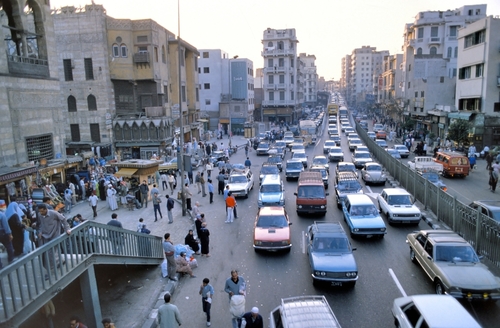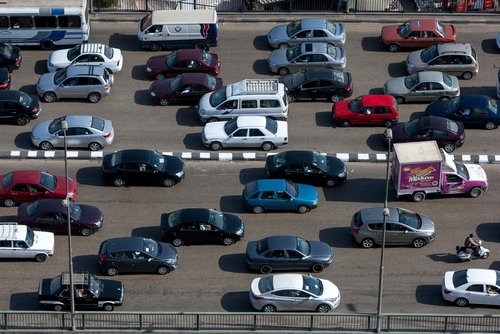Cairo, the sprawling capital of Egypt, is a city of incredible contrasts. Ancient wonders stand beside modern skyscrapers, and quiet, historic alleyways open into bustling avenues. For many visitors, one of the most striking features of this vibrant metropolis is its traffic. Navigating the streets of Cairo is an unforgettable experience, in large part because of one missing element: traffic lights.
This guide will explain why Cairo has so few functioning traffic lights. We will look at the city’s unique driving culture, the role of traffic police, and past attempts to manage the flow of vehicles. Understanding these factors provides a clearer picture of how one of the world’s largest cities keeps moving.
Cairo’s Unique Traffic Culture
To understand why traffic lights are largely absent in Cairo, it’s essential to first understand the city’s distinct driving culture. With a population of over 22 million in its greater metropolitan area, Cairo’s roads are among the busiest in the world. The flow of traffic is managed not by automated signals, but by an informal system of communication and negotiation among drivers.
An Unwritten Code of Conduct
Drivers in Cairo rely heavily on eye contact, hand gestures, and the strategic use of their horns to communicate their intentions. A short honk might mean “I’m here,” while a longer one could signal “I’m coming through.” This constant interaction creates a fluid, organic flow that might seem chaotic to an outsider but is understood by local drivers. In this environment, rigid, automated systems like traffic lights could disrupt the established rhythm.
The Role of Pedestrians
Pedestrians also play an active role in this system. Crossing a multi-lane street in Cairo often requires confidence and precise timing. People navigate through moving traffic by making eye contact with drivers and finding gaps in the flow of cars. This dynamic interaction between pedestrians and vehicles is another reason why fixed traffic signals are not a central part of the city’s infrastructure.

The Presence of Traffic Police
While traffic lights are scarce, traffic police are a common sight at major intersections across Cairo. These officers take on the role that automated signals would otherwise perform, directing the flow of vehicles with hand signals and whistles.
Human-Led Traffic Management
Traffic officers provide a more flexible approach to managing intersections. They can adapt in real-time to changing conditions, such as accidents, unexpected congestion, or the need to clear a path for emergency vehicles. This human element allows for a level of responsiveness that a pre-programmed traffic light system cannot match. An officer can hold traffic on a less busy street to allow a major artery to clear, making decisions based on the immediate situation.
Why Human Direction is Preferred
In a city with such dense and often unpredictable traffic patterns, the adaptability of police officers is considered more effective than the fixed cycles of traffic lights. Past attempts to install automated signals have often failed because they couldn’t adjust to the fluid reality of Cairo’s streets, leading to greater congestion and frustration among drivers.
Past Attempts and Infrastructure Challenges
Cairo has experimented with traffic lights in the past, but these initiatives have faced significant challenges. Many of the signals that were installed are no longer in operation.
Maintenance and Enforcement Issues
One of the primary reasons for the failure of traffic light systems is the difficulty of maintenance. The city’s dusty climate can obscure lenses, and frequent power outages can render the signals useless. Furthermore, enforcing traffic light compliance has proven difficult. Without consistent enforcement, drivers often ignore the signals, reverting to the informal system they know best.
Cultural Resistance
There is also a cultural element to consider. Cairene drivers are accustomed to their method of negotiating traffic. The introduction of an automated system that removes their ability to communicate and make split-second judgments can be seen as an obstacle rather than a solution. The transition to a signal-based system would require a significant shift in driving habits, which has been difficult to achieve.
The Future of Traffic in Cairo
Managing traffic remains a key priority for Cairo’s city planners. While a city-wide system of traffic lights may not be on the immediate horizon, other solutions are being explored to ease congestion.
The government has invested heavily in expanding the Cairo Metro, building new bridges and overpasses, and improving public transportation networks. These infrastructure projects are designed to reduce the number of cars on the road and provide residents with more efficient ways to travel across the city. By addressing the root cause of traffic—the sheer volume of vehicles—these initiatives aim to make Cairo’s streets more manageable for everyone.
Getting Around Cairo Safely
For those visiting Cairo, navigating the city’s traffic can feel intimidating. However, by understanding the local customs, you can move around safely. When crossing the street, it is best to follow the lead of locals. Wait for a group to cross together and move confidently and predictably.
Using ride-sharing apps like Uber or hailing a local taxi are convenient ways to travel. These drivers are experts at navigating Cairo’s unique traffic system. The Cairo Metro is another excellent option for avoiding road traffic altogether, especially for longer distances.
FAQs About Cairo’s Traffic
Are there any traffic lights at all in Cairo?
Yes, there are a few traffic lights in some areas of Cairo, particularly in newer developments or specific neighborhoods like Heliopolis. However, they are not widespread, and many are not operational. The vast majority of intersections rely on traffic police or the informal system of driver negotiation.
How do people cross the street without traffic lights?
Pedestrians cross the street by finding gaps in traffic and communicating with drivers through eye contact. It is common to see people confidently weaving through slow-moving cars. For visitors, it’s recommended to cross with a group of locals or use designated pedestrian bridges where available.
Is driving in Cairo dangerous?
Driving in Cairo can be challenging for those unfamiliar with the local driving culture. The system relies on unwritten rules and constant communication between drivers. While it may appear chaotic, local drivers are highly skilled at navigating it. For tourists, it’s generally easier and safer to rely on taxis, ride-sharing services, or public transportation.
